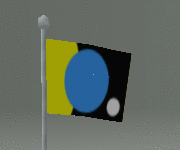The many uses of the Flag of Earth
The Flag of Earth could be flown if you are conducting a project or event which benefits the Earth as a whole ... not just your community or country. For instance, if you are using a "green" source of energy, such as solar energy or windmills, then fly the flag to underscore your thoughtful consideration of the Earth's resources.
Earth Day - April 22nd - is the perfect day to fly the Flag of Earth. If you are participating in a neighborhood cleanup, get members of your crew Flag of Earth pins to wear on their shirts or decals for their backpacks. On Earth Day you join others across the Earth in celebrating the treasure we know as "Nature".
Do you drive a hybrid car? Then a Flag of Earth decal is perfect for your car's bumper!
Are you a scientist conducting research in the Search for Extraterrestrial Intelligence? Since an alien has not targeted any one nation to receive its broadcast, you can proudly fly the Flag at your research facility.
Are you a grade school science teacher? The Flag of Earth is an excellent illustration of the macrocosm in which we live: The Earth receives light and heat from the Sun, providing the engine which runs the Earth's water cycle and the changing of the seasons. The Moon generates the ocean's tides, generating saltwater marshes, and currents which provide nutrients for billions of creatures.
Are you a ham radio operator, contacting other operators around the world? Your skills will be very useful if there is some large-scale disaster, so you can ask for help, or provide help, to others around the world. This is truly a skill which benefits the Earth. Fly your Flag of Earth next to your antennas, to indicate that your project benefits all Earth's countries.
Are you flying the Flag of Earth right now? We'd love to hear about it. Send us your story and a link to a picture of you and your Flag, so we can add you to our Flown page.
Do you have other suggestions for when to fly the Flag of Earth? Tell us your ideas on our Contact page.
